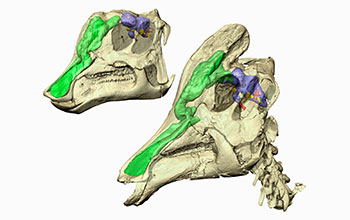Multimedia Gallery
Corythosaurus Skulls
A cat (CT) scan reconstruction of the skull of a juvenile and sub-adult Corythosaurus; the nasal cavity is green, and the brain purple. New research by scientists using this cutting-edge visualization and reconstruction technique shows that duck-billed dinosaurs likely communicated via sound and signal. [See related image Here.]
More about this Image
Paleontologists have long debated the function of the strange, bony crests on the heads of the duck-billed dinosaurs known as lambeosaurs. The structures contain incredibly long, convoluted nasal passages that loop up over the tops of their skulls. Some paleontologists believe the crests heightened the sense of smell by increasing the surface area of the sensory tissue, while others have argued that they regulated temperature. Still others have speculated that the crests acted as sound resonators for communication. Now, scientists at the University of Toronto, Ohio University and Montana State University have used CT-scanning to look inside these mysterious crests and reconstruct the brains and nasal cavities of four different lambeosaur species.
By using and analyzing CT scans, conducted by Lawrence Witmer and Ryan Ridgely of Ohio University's College of Osteopathic Medicine, the scientists were able to circumvent the problems of fossilization. "It's difficult to infer the function of structures in an extinct dinosaur when there is so little resemblance to any living animal," said Jack Horner, a member of the team and a paleontologist at Montana State University.
CT scan results revealed a mismatch between the external shape of the crest and the internal shape of the nasal passages in closely related species, suggesting a special function for the nasal cavity. The portion of the brain responsible for the sense of smell was relatively small and primitive, indicating the crest did not evolve to improve that particular sense. Computer models by other researchers suggest the crests could have been used to make low, eerie bellowing calls--a possible form of communication, perhaps to call for mates or warn of predators. CT scans also documented a delicate inner ear, confirming that the dinosaurs would have been able to hear the low-frequency calls produced by the crest.
"These scientists have used cutting-edge visualization and reconstruction techniques to show that duck-billed dinosaurs likely communicated via sound and signal," said Adam Summers, a program director in the National Science Foundation's (NSF) Division of Integrative and Organismal Systems. This research was funded by NSF (grants IOS 05-17257, IBN 03-43744 and IBN 96-01174) and the Engineering Research Council of Canada. (Date of Image: October 2008)
Credit: Courtesy of Witmer & Ridgely, Ohio University
See other images like this on your iPhone or iPad download NSF Science Zone on the Apple App Store.
Images and other media in the National Science Foundation Multimedia Gallery are available for use in print and electronic material by NSF employees, members of the media, university staff, teachers and the general public. All media in the gallery are intended for personal, educational and nonprofit/non-commercial use only.
Images credited to the National Science Foundation, a federal agency, are in the public domain. The images were created by employees of the United States Government as part of their official duties or prepared by contractors as "works for hire" for NSF. You may freely use NSF-credited images and, at your discretion, credit NSF with a "Courtesy: National Science Foundation" notation.
Additional information about general usage can be found in Conditions.
Also Available:
Download the high-resolution JPG version of the image. (1.5 MB)
Use your mouse to right-click (Mac users may need to Ctrl-click) the link above and choose the option that will save the file or target to your computer.



